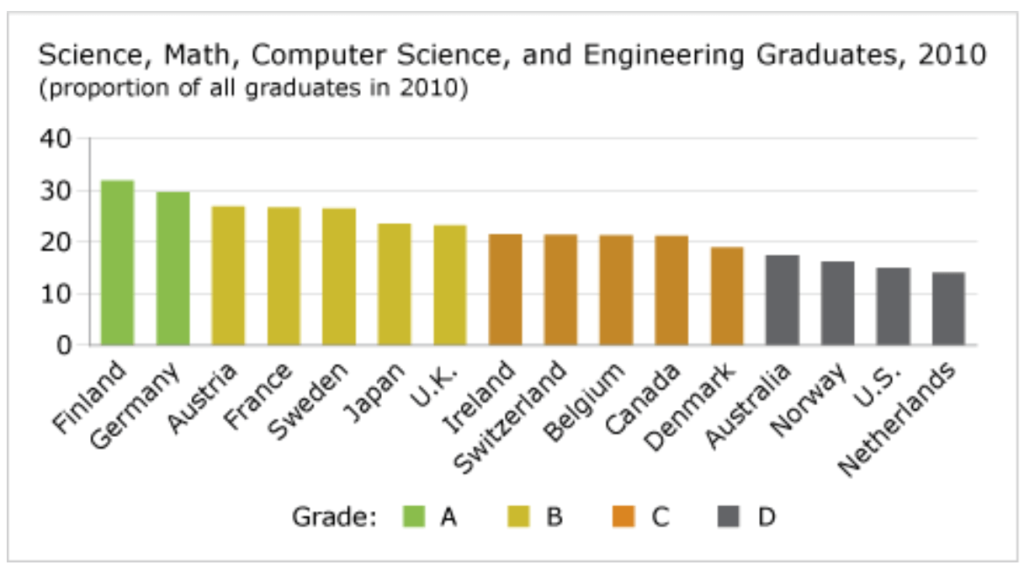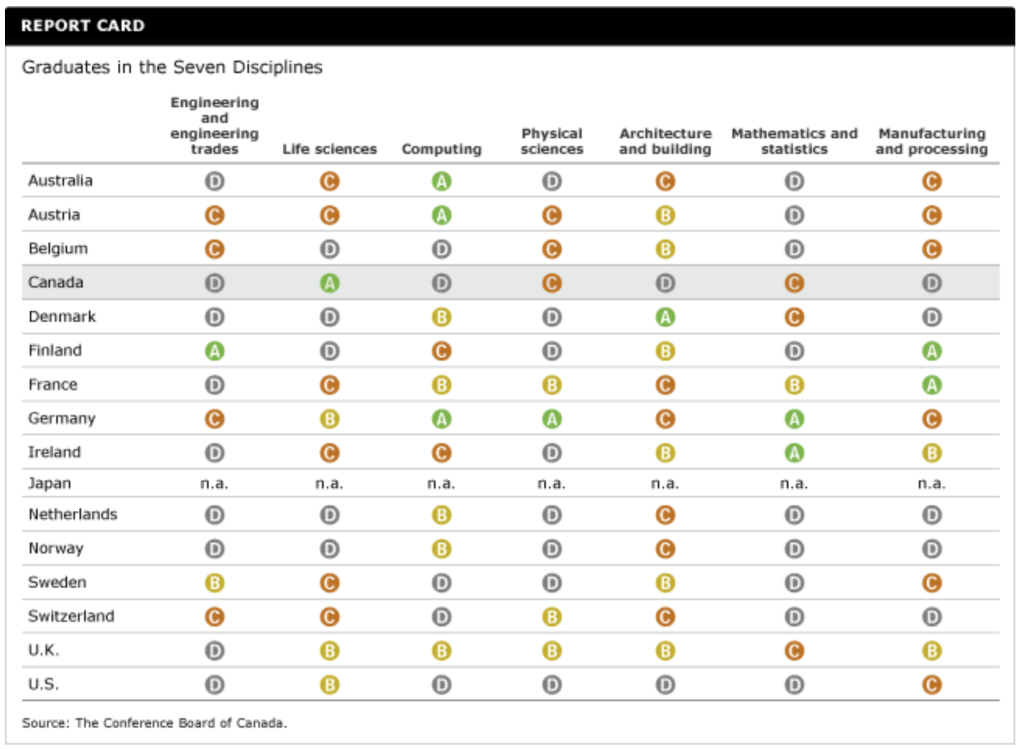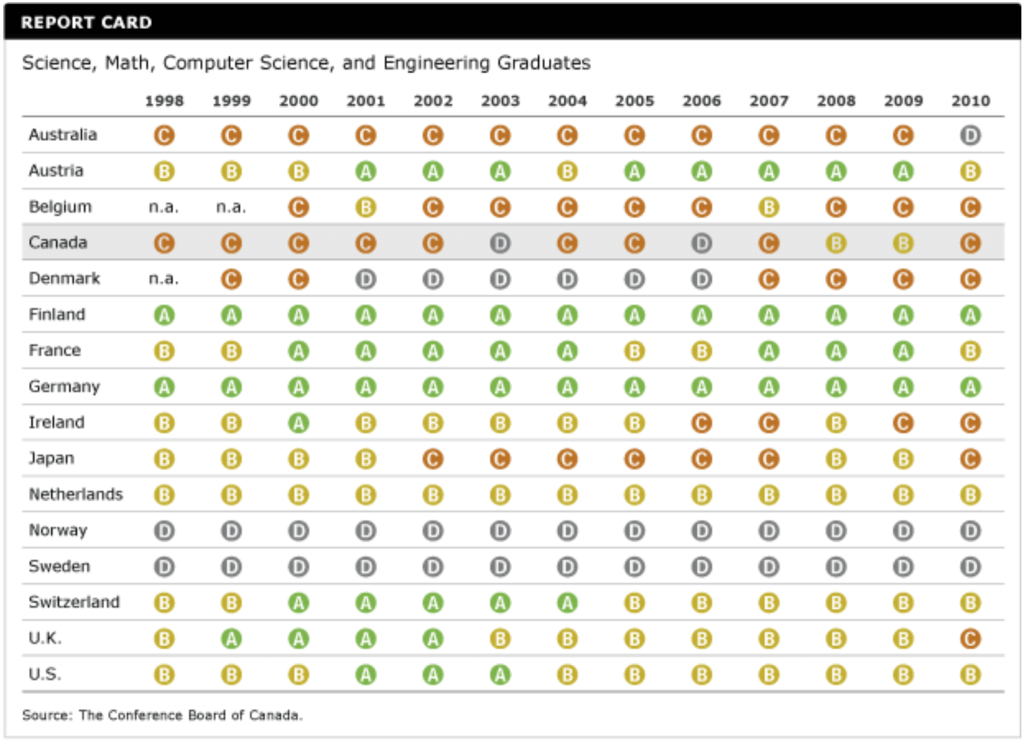Percentage of Graduates in Science, Math, Computer Science, and Engineering
Key Messages
- Canada gets awarded a “C” and ranks 12th out of 16 peer countries.
- In 2010, Canada’s proportion of overall graduates emerging from science, math, computer science, and engineering disciplines was 21.2 per cent, the third year of decline.
- Canada does relatively well on life science, but poorly on engineering and computer science.

Putting science, math, computer science, and engineering graduates in context
It has long been argued, based on income data, that university completion is the most relevant indicator of Canada’s ability to produce highly talented, innovative people. Studies show that the choice of discipline matters to outcomes as well. One recent study, for example, found that males with university degrees in academic disciplines—such as the humanities, education, biology, and agriculture science—earned less than half of that earned by males with university degrees in vocational and applied disciplines—such as commerce, medicine, and engineering.1 Many of Canada’s peer countries have a strong mathematics and scientific culture that permeates all levels of their education system. These disciplines are widely considered to be the underpinnings of innovation capacity.
How does Canada’s most recent grade compare to that of its peer countries?
Canada’s relatively low proportion of graduates emerging from science, math, computer science, and engineering disciplines is cause for concern. Canada gets a “C” grade and ranks 12th out of 16 countries. In 2010, Canada ranked 9th. Only 21 per cent of Canada’s university graduates in 2010 were from science, math, computer science, or engineering disciplines. In Finland, 32 per cent of all university graduates were from these disciplines. Although we don’t include emerging economies in our peer group of countries, Canada needs to keep abreast of new global competitors like China and India, which are producing these kinds of graduates at an ever-increasing rate.
Does Canada do well in any of these disciplines?
Seven disciplines make up this indicator:
- engineering and engineering trades (6.1 per cent of Canada’s total graduates in 2010)
- life sciences (6.4 per cent of Canada’s total graduates in 2010)
- computing (2.1 per cent of Canada’s total graduates in 2010)
- physical sciences (2.9 per cent of Canada’s total graduates in 2010)
- architecture and building (2.0 per cent of Canada’s total graduates in 2010)
- mathematics and statistics (1.4 per cent of Canada’s total graduates in 2010)
- manufacturing and processing (0.2 per cent of Canada’s total graduates in 2010)
Canada gets an “A” for the relatively high share of students graduating in life sciences (e.g., biology, biochemistry). Canada’s worst grades are in engineering, computing, architecture and building, and manufacturing and prcessing. No one country does well in all seven disciplines.
Of the seven disciplines, engineering and engineering trades is Canada’s largest, representing 6.1 per cent of total graduates in 2010. Yet Canada receives only a “D” in this discipline, because other countries have a much higher share. In Finland, for example, 18 per cent of all graduates in 2010 were in engineering and engineering trades. The share was 14 per cent in Sweden.

Has Canada improved its relative performance?
Canada fell from a “B” in 2007 to a “C” in 2008, 2009, and 2010. Canada’s percentage of overall graduates that emerged from science, math, computer science, and engineering disciplines was 21.2 per cent, an increase of 1.4 percentage points from 1998.

Does field of study matter?
Canadians with scientific degrees tend to earn more. Five years after graduation, engineers earn about $10,000 more annually than fine arts and humanities graduates, and upwards of $5,000 more than social science graduates. These earnings are in line with computer and physical sciences, although agricultural and biological sciences tend to earn around the same as social science graduates.
It is less clear whether the number of science, math, computer science, and engineering graduates matters between countries. The two top countries on income per capita, Norway and the U.S., for example, are among the worst performers on this indicator. Meanwhile, Finland and Germany, which produce some of the most science, math, computer science, and engineering graduates proportionately, are among the worst on income per capita performance. Moreover, if productivity levels were clearly aligned with the proportion of science, math, and engineering graduates in a given country, we would expect to see the rankings between the two indicators align. But this is true in less than one third of the cases.
Although the link between graduates in these disciplines and economic outcomes may not be a direct one, the Conference Board has long argued that there is a relationship between strategic investments in these fields and future economic prosperity. Canadian authors who analyzed math and reading test results of young Canadians further emphasized the need to ensure that today’s education system will provide students with the knowledge and skills needed to succeed in tomorrow’s economy:
The skills and knowledge that individuals bring to their jobs, to further studies, and to our society, play an important role in determining our economic success and our overall quality of life. The importance of skills and knowledge is expected to continue to grow. The shift from manufacturing to knowledge and information intensive service industries, advances in communication and production technologies, the wide diffusion of information technologies, falling trade barriers, and the globalization of financial markets and markets for products and services have precipitated changes in the skills the present and future economy requires. These include a rising demand for a strong set of foundation skills upon which further learning builds.2
It’s not good enough simply to produce more graduates. Canada needs to target funding and education policy reforms at areas relevant to the new knowledge economy. Moreover, graduates in math, science, computer science, and engineering will need to be supported by appropriate policies and strategies that will see their innovations developed, diffused, and successfully marketed. In analyzing the Innovation report card, the Conference Board concludes that Canada does not take the steps that other countries do to ensure science outputs can be successfully commercialized and used as a source of advantage for innovative companies seeking global market share. Canadian companies are thus rarely at the leading edge of new technology and too often find themselves a generation or more behind the productivity growth achieved by global industry leaders.
Would improved recognition of foreign credentials help the situation?
Yes. One route the Conference Board has recommended for improving the number of highly skilled workers is to improve the system for recognizing the learning of immigrants. For example, many of the 1.5 million immigrants to Canada between 1986 and 1996 had post-secondary credentials. Yet their entry into the Canadian labour market and educational system was not easy. The scale of the problem is well illustrated by the example of foreign-trained engineers. From 1991 to 1994, 10,279 immigrants arrived listing engineering as their intended occupation, yet only 56 per cent of them are practicing this profession in Canada. The non-accreditation of foreign-born professionals and tradespeople is a problem rooted in multiple barriers that cut across a wide range of institutional layers.
Brain Gain: The Economic Benefits of Recognizing Learning and Learning Credentials in Canada, Ottawa: The Conference Board of Canada, 2001.
Footnotes
1 Alan Stark, Which Fields Pay, Which Fields Don’t? An Examination of the Returns to University Education in Canada by Detailed Field of Study (Ottawa: Department of Finance Canada, February 2007).
2 Patrick Bussière, Fernando Cartwright, and Tamara Knighton, Measuring Up: Canadian Results of the OECD PISA Study (Ottawa: Human Resources and Skills Development Canada and Statistics Canada, 2004), 10.

